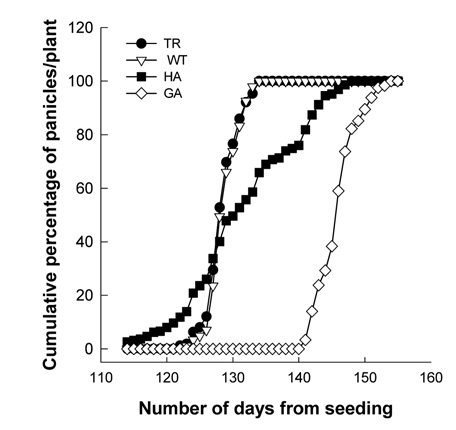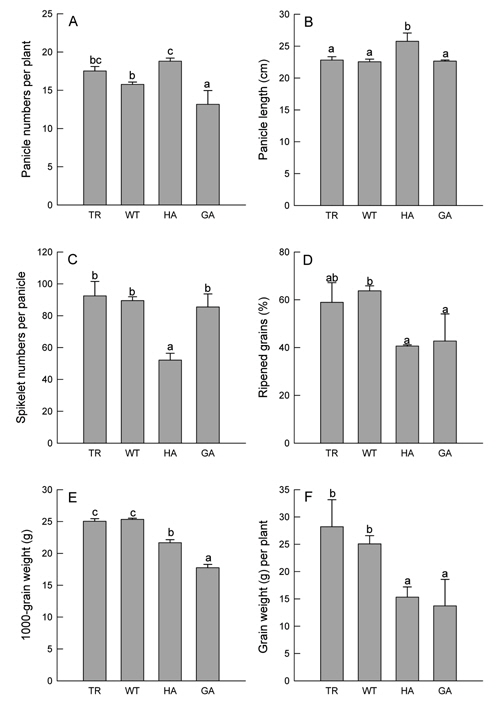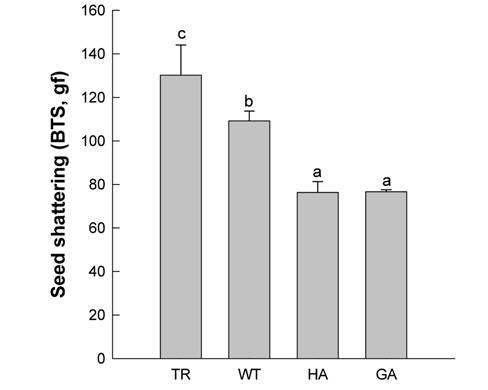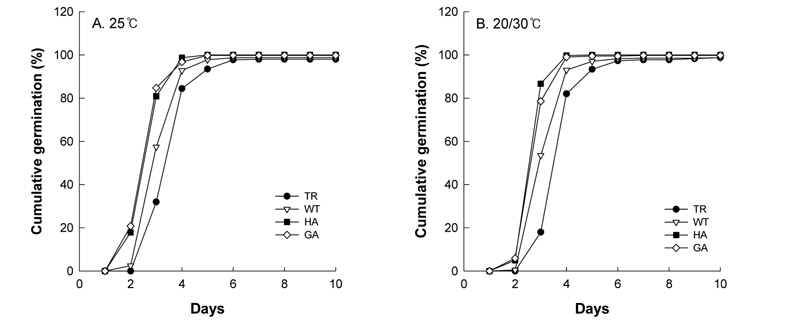



The phenotypic traits of herbicide-tolerant transgenic rice were compared with those of wild type (Dongjin) as well as two accessions (Hwaseong-aengmi 1 and Gwangyang-aengmi 12) of weedy rice. This study was conducted to investigate whether unintentional alterations in phenotypic characteristics occurred in the transgenic rice and whether the altered traits were similar to those in the two weedy rices. All qualitative traits studied were similar in the transgenic or wild-type rice. On the other hand, awn presence, flag leaf attitude and grain color differed considerably between herbicide-tolerant transgenic rice and weedy rice. As for quantitative traits, plant height, the number of tillers per plant and shoot dry weight were significantly greater for weedy rice than transgenic or wild-type rice. Grain weight per plant and 1000-grain weight of transgenic (or wild-type) rice were significantly greater than those of weedy rice. Transgenic rice shattered less than the other rices. Amylose and protein contents in embryos of transgenic rice were significantly different from those of weedy rice. The potential for weediness of the transgenic rice may be assessed using phenotype comparison between transgenic and weedy rice as shown in this study.
식물생명공학기술의 급속한 발전에 따라 제초제 내성, 해충저항성, 환경스트레스 내성 등 다양한 형질을 갖는 형질전환 작물의 개발 및 재배가 증가하고 있다. 형질전환작물 개발은 부족한 식량 생산에 대응하기 위한 한 가지 방안으로 간주되고 있지만, 형질전환 작물의 잠재적 위해성에 대한 우려 역시 계속되고 있다(Snow et al., 2005; Tiedje et al., 1989). 그 중 하나는 형질전환 작물이 유해잡초가 되어 농업생산성을 감소시키고, 자연생태계에 침입할 가능성이다(Keeler, 1989; Parker and Kareiva, 1996). 따라서 형질전환 작물을 재배하기 이전에 잡초화 가능성에 대한 충분한 평가가 이루어져야 할 필요가 있다(Purrington and Bergelson, 1995).
형질전환 작물의 잡초화 가능성을 평가하기 위해서는 작물의 생활사, 경합력, 분산능, 종자의 휴면과 지속성 등 다양한 속성에 대한 검토가 필요하다(Crawley, 1990). 형질전환 유채와 모본의 경합력을 비교한 연구(Fredshavn et al., 1995; Ramachandran et al., 2000)와 형질전환 클로버와 모본의 경합력을 비교한 연구(Godfree et al., 2004) 등 이 보고되었으며, 환경에서 형질전환 유채 종자의 지속성(Crawley et al., 1993; Hails et al., 1997) 및 감자의 지속성에 대한 연구(Kim et al., 2010)도 보고된 바 있다. 호주에서는 형질전환 목화를 대상으로 적응도(fitness)를 조사하거나(Eastick and Hearnden, 2006) 잡초위해성평가 프로토콜에 적용하여 형질전환 목화의 잡초화 가능성이 낮다고 판단한 사례도 있다(Rogers et al., 2007).
형질전환 작물의 잡초화 가능성을 평가하기 위한 상기방법과 함께 형질전환 작물의 표현형과 잡초성 근연종의 표현형을 비교함으로써 형질전환 작물의 잡초화 가능성을 예측하는데 도움이 될 것으로 판단된다. 잡초성 근연종은 우세한 경합력과 탈립성 등 작물과 구분할 수 있는 뚜렷한 특성을 갖기 때문에, 만약 형질전환으로 인해 모본과는 달리 잡초성 근연종에 보다 가까운 표현형이 나타난다면 그 형질전환 작물의 잡초화 가능성이 높다고 판단할 수 있을 것이다. 이와 같은 표현형의 비교는 주로 형질전환 작물과 근연종과의 교잡집단을 대상으로 이루어져 왔다(Kim et al., 2004; Oard et al., 2000; Song et al., 2011).
잡초성 벼는 동남아시아, 아메리카 및 남부 유럽 등 세계 대부분의 쌀 생산 지역에서 재배 벼의 수확량과 품질을 감소시키는 주요 잡초다(Busconi et al., 2012; Song et al., 2011). 아시아의 이앙 논에서는 잡초성 벼가 성공적으로 방제되어 왔지만, 이앙 논이 담수직파 논으로 바뀌는 지역에서는 방제에 어려움을 겪고 있다(Delouche et al.,2007). 잡초성 벼는 오랜 기간 동안 재배 벼와 동일한 지역에 분포하면서 자연교잡 및 유전자 이입 등을 통하여 재배 벼와 유사한 형태와 생리를 갖게 되었지만, 종자가 쉽게 탈립하며 장기간 휴면을 하는 등 일부 특성에서 재배 벼와 차이가 있는 것으로 알려져 있다(Ellstrand et al., 2010; Xia et al., 2011).
본 연구에서는 PPO (protoporphyrinogen oxidase) 유전자를 도입하여 PPO 저해 제초제에 대한 내성을 갖도록 개발된 형질전환 벼(Lee et al., 2007)를 재료로 하여 모본인 동진벼와 잡초성 벼 두 계통과의 표현형의 특성을 비교하였다. PPO 유전자가 도입된 벼에서 모본보다 잡초성벼와 더 가까운 특성이 나타나는지를 관찰함으로써 PPO유전자 도입 형질전환 벼의 잡초화 가능성을 평가하는 기초자료로 활용하고자 하였다.
농촌진흥청으로부터 환경방출실험승인(승인번호 2012-020)을 받은 뒤 충북 청원군 오창읍에 위치한 한국생명공학연구원 격리포장(농촌진흥청 지정번호 RDA-가AB-2011-013)에서 포장시험을 수행하였다.
PPO 저해 제초제내성 형질전환 벼(
볍씨는 2012년 4월 12일에 파종하였으며, 35일 후 격리포장에 손이앙하였다. 실험구는 3반복 난괴법으로 배치하였으며, 관행농법에 따라 재배하였다. 2012년 8월과 9월에 벼의 출수기를 관찰하였으며, 탈립으로 인한 종자의 소실을 막기 위하여 출수 후 벼의 화서를 그물망으로 씌워 수확기까지 유지하였다. 2012년 10월 16일에 각 실험구별로 10주씩을 수확하여 형질을 조사하였다. 양적형질과 질적형질 조사는 농촌진흥청의 농업과학기술 연구조사분석기준(안) (2003) 및 국립종자관리소의 신품종 심사를 위한 작물별 특성조사요령(벼) (2005)를 참고하여 실시하였다(Table 1). 또한, 벼의 종실인장강도(grain breakage tensile strength)를 측정하여 탈립성의 척도로 사용하였다(Ji et al.,2006).
[Table 1.] Measurement methods for phenotype assessment of transgenic, wild-type and weedy rice.
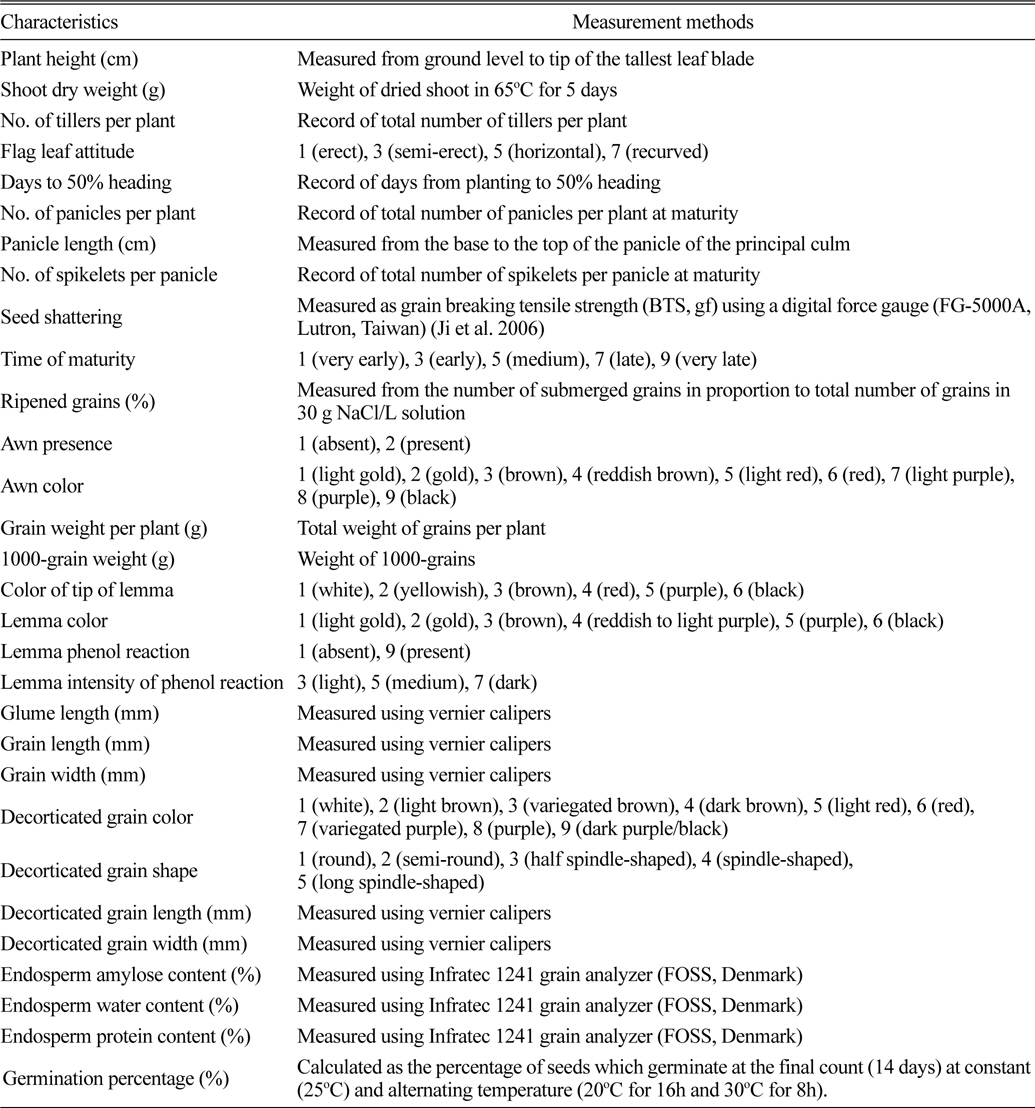
Measurement methods for phenotype assessment of transgenic, wild-type and weedy rice.
벼 유전형이 각 형질에 미치는 영향은 일원일차분산분석(one-way ANOVA)으로 5% 유의수준에서 검정하였으며, 분산분석 결과 통계적으로 유의한 차이가 관찰될 경우 Tukey's HSD 검정을 이용하여 평균의 차이를 검정하였다. 모든 통계분석은 Statistica (Version 8.0, Statsoft) 통계 패키지를 이용하여 실시하였다.
형질전환 벼와 모본의 질적 형질은 모두 다르지 않았으므로(Table 2) 형질전환으로 인하여 PPO 저해 제초제에 대한 내성 획득 이외의 다른 질적 형질은 변하지 않은 것으로 판단된다. 반면 화성앵미 1과 광양앵미 12의 질적형질은 형질전환 벼 및 모본과 큰 차이가 있었다. 형질전환벼와 모본의 지엽은 직립하였지만, 화성앵미 1의 지엽은 수평이었으며, 광양앵미 12의 지엽은 반직립하였다(Table 2).또한 형질변화 벼와 동진벼의 종실에는 까락이 없었지만 잡초성 벼의 종실에는 갈색 까락이 있었다. 까락은 잡초성 벼에서 관찰되는 특성 중 하나로 경기지역에서 수집한 잡초성 벼 170개 계통 중 71%에서(Park et al., 1999), 전국적으로 수집한 1,300 여개 계통의 잡초성 벼 중 61%에서(Suh, 2003) 까락이 관찰된 바 있다.
[Table 2.] Qualitative characteristics of transgenic, wild-type and weedy rice.
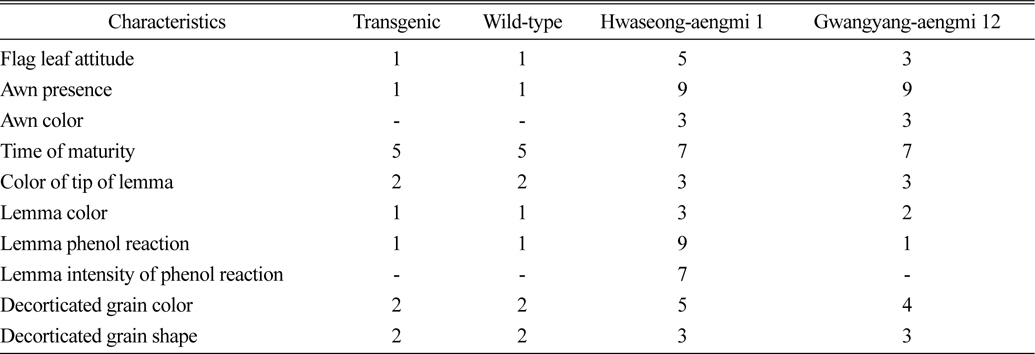
Qualitative characteristics of transgenic, wild-type and weedy rice.
형질전환 벼와 모본의 성숙기는 중간이었지만, 잡초성벼의 성숙기는 늦은 것으로 나타났다(Table 2). 부선색은 형질전환 벼와 모본이 연노랑색인 반면에, 잡초성 벼는 갈색이었다. 외영의 페놀 반응은 화성앵미 1에서만 진하게 나타났다. 페놀 반응은 주로 Indica 형 잡초성 벼에서 나타나는 특성으로 알려져 있지만 Japonica 형 잡초성 벼의 31%에서도 페놀 반응이 관찰되었다(Suh et al., 1992a). 형질전환 벼와 모본의 현미 색은 황금색인 반면에, 화성앵미 1과 광양앵미 12는 각각 담적색과 짙은 갈색이었다. 잡초성 벼는 현미 색이 적색, 갈색 및 흑색인 계통도 보고 되고 있으며(Park et al., 1999; Suh et al., 1992a), 이와 같은 잡초성 벼 현미의 다양한 색은 재배 쌀의 품질을 감소시키는 원인이 된다. 화성앵미 1과 광양앵미 12는 모두 중 원형으로 장폭비가 2.00~2.49의 범위 내에 있었다. 따라서 화성앵미 1과 광양앵미 12는 Indica 형인 장립형 잡초성벼가 아닌 Japonica 형인 단립형 잡초성 벼에 해당된다(Suh et al., 1992a). 형질전환 벼와 모본은 모두 장폭비가1.50~1.99의 범위에 있는 단원형으로 장폭비가 더 작았다.
양적형질 대부분은 벼의 유전형에 따라 통계적으로 유의한 차이를 나타냈다. 영양생장은 형질전환 벼나 모본보다 잡초성 벼에서 우세했다(Fig. 1). 초장은 화성앵미 1과 광양앵미 12가 형질전환 벼와 모본에 비해 각각 22%와 40% 더 크게 나타났다(Fig. 1A). 이와 같이 잡초성 벼의 큰 초장은 재배 벼와의 광 경합에서 유리한 형질이 될 수 있다(Kuk et al., 1997; Suh et al., 1992b). 분얼 수는 화성앵미 1이 형질전환 벼나 모본에 비해 유의하게 더 많았다(Fig. 1B). 지상부 건물중은 분얼이 많고, 키가 큰 잡초성벼 두 계통이 형질전환 벼나 모본에 비해 더 무거웠으나 통계적인 차이는 형질전환 벼 및 모본과 광양앵미 12 사이에서만 관찰되었다(Fig. 1C).
형질전환 벼와 모본의 개화시기는 일치하였는데, 파종 후 126일에 출수를 시작하여 132일째 출수를 마쳤으며, 출수기까지 128일이 소요되었다(Fig. 2). 화성앵미 1은 파종 후 121일째부터 출수를 시작하여 형질전환 벼나 모본에 비해 출수는 빨랐지만, 143일째에 출수를 마쳐 전체 출수 기간은 가장 길었다. 광양앵미 12는 전체적인 출수 기간은 짧았으나 다른 벼에 비해 출수시가 늦어 파종 후 142일째에 출수를 하였고, 출수기까지 148일이 소요되었다.
생식생장은 전반적으로 형질전환 벼와 모본의 형질이 잡초성 벼에 비해 더 우세하였다. 주당 수수는 화성앵미1이 가장 많은 반면 광양앵미 12가 가장 적었으며, 수장은 화성앵미 1이 유의하게 가장 길었다(Fig. 3A, B). 수당 영화수는 화성앵미 1이 가장 적었고, 나머지 벼는 차이가 없었다(Fig. 3C). 광양앵미 12와 모본의 주당 영화수는 서로 통계적인 차이가 없었다. 모본의 등숙율은 화성앵미 1과 광양앵미 12의 등숙율에 비해 유의하게 높았다(Fig.3D). 또한, 주당 종실중과 천립중 모두 잡초성 벼 두 계통이 형질전환 벼 및 모본에 비해 더 가벼웠다(Fig. 3E, 3F).
형질전환 벼는 종실인장강도가 잡초성 벼에 비해 높게 나타나 탈립이 쉽게 일어나지 않음을 알 수 있었다(Fig. 4).국내에서 조사한 809계통의 재래 적미 중 85%에서 탈립이 쉽게 일어남이 보고된 바 있다(Suh et al., 1992a). 따라서 형질전환 벼가 쉽게 탈립하지 않는다는 것은 이 벼의 잡초화 가능성이 낮음을 나타내는 하나의 지표가 될수 있을 것이다.
호영 상부와 하부 길이 및 호영 폭은 형질전환 벼와 모본에 비해 광양앵미 12에서 더 짧았다(Table 3). 광양앵미12의 벼알 길이 및 폭, 현미의 길이 및 폭이 가장 짧았다. 잡초성 벼 종자 배유의 아밀로스 함량은 형질전환 벼와 모본에 비해 유의하게 낮았지만, 단백질 함량은 높았다(Table3). 국내에서 수집된 Indica 형 잡초성 벼의 아밀로스 함량은 20~26%였으며(Heu et al., 1990), 주로 Indica 형인 미국의 잡초성 벼의 아밀로스 함량 또한 22 ~ 26%로 보고된 바 있다(Gealy and Bryant, 2009). 본 실험에서 형질전환 벼와 모본의 아밀로스 함량은 15% 정도로 이보다 낮았으며, 화성앵미 1과 광양앵미 12는 5% 정도로 낮았다. 배유의 수분 함량은 벼 계통 간에 유의한 차이가 없었다.
[Table 3.] Grain size and endosperm characteristics of transgenic, wild-type and weedy rice.

Grain size and endosperm characteristics of transgenic, wild-type and weedy rice.
25°C 항온과 20°C / 30°C 변온 조건에서 벼의 유전형에 따른 발아율 차이는 관찰되지 않았다(Fig. 5). 그러나 항온과 변온 조건에서의 발아속도는 화성앵미 1과 광양앵미12가 형질전환 벼와 모본에 비해 빠른 것으로 나타났다. 잡초성 벼는 항온 조건과 변온 조건에서 100% 가깝게 발아하였으며, 휴면성은 거의 없었다. 종자의 휴면성은 잡초성 벼의 특징 중 하나이지만(Ellstrand et al., 2010; Xia et al., 2011), 한국 재래 적미의 수확 직후 발아율이 99% 이상으로 높아 휴면성이 없었다는 보고도 있다(Suh and Ha,1993).
이상과 같이 PPO 저해 제초제 내성 형질전환 벼는 모본인 동진벼와 표현형을 비교하였을 때 질적형질은 동일 하였고, 양적형질 중 일부(낮은 탈립성, 높은 아밀로스 함량, 긴 현미 길이) 형질에서는 모본과 유의하게 차이가 났지만, 나머지 형질에서는 통계적인 차이가 관찰되지 않았다. 형질전환 벼의 표현형은 이와 같이 대부분 재배품종인 동진벼와 유사하였지만, 잡초성 벼의 표현형과는 질적, 양적으로 큰 차이가 있었다. 이와 같은 결과로 PPO 저해 제초제에 내성을 갖는 유전자를 벼에 도입하였을 때 근연잡초인 잡초성 벼와 유사한 표현형을 나타내지 않으며, 목적 형질을 제외하고 나머지 형질은 모본과 유사하여 잡초화 가능성은 낮다고 판단하였다.
형질전환 벼의 잡초화 가능성을 보다 정확히 예측하기 위해서는 경합력, 자연 환경에서의 휴면성, 월동성, 생활사 변화 등의 평가가 종합적으로 이루어져야 할 것이다. 또한 본 실험과 같이 형질전환 벼와 잡초성 벼의 표현형을 비교한다면 형질전환 벼의 잡초화 가능성을 예측하는 기초 자료로 활용할 수 있을 것이다.



